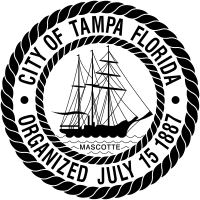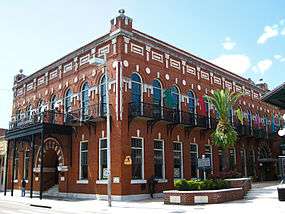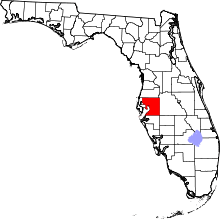Tampa, Florida
| Tampa, Florida | |||
|---|---|---|---|
| City | |||
| City of Tampa | |||
|
Images from top, left to right: Skyline of Downtown Tampa, Amalie Arena, Ybor City, Henry B. Plant Museum, Raymond James Stadium, Busch Gardens Tampa Bay | |||
| |||
| Nickname(s): Cigar City,[1] The Big Guava[2] | |||
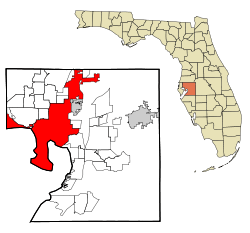 Location in Hillsborough County and the state of Florida | |||
 Tampa Location in the United States | |||
| Coordinates: 27°58′05″N 82°28′35″W / 27.96806°N 82.47639°WCoordinates: 27°58′05″N 82°28′35″W / 27.96806°N 82.47639°W | |||
| Country |
| ||
| State |
| ||
| County |
| ||
| Settled | 1823 | ||
| Incorporated (Village) | January 18, 1849 | ||
| Incorporated (Town) |
September 10, 1853 and August 11, 1873 | ||
| Incorporated (City) |
December 15, 1855 * and July 15, 1887 | ||
| Government | |||
| • Type | Mayor-council | ||
| • Mayor | Bob Buckhorn (D) | ||
| • Legislative | Tampa City Council | ||
| Area | |||
| • City | 170.6 sq mi (441.9 km2) | ||
| • Land | 112.1 sq mi (290.3 km2) | ||
| • Water | 58.5 sq mi (151.6 km2) 34.3% | ||
| • Urban | 802.3 sq mi (2,078 km2) | ||
| • Metro | 2,554 sq mi (6,610 km2) | ||
| Elevation | 48 ft (14.6 m) | ||
| Population (2013)[3] | |||
| • City | 369,075 | ||
| • Rank | 53rd in the US | ||
| • Density | 2,969.6/sq mi (1,146.7/km2) | ||
| • Urban | 2.4 million (17th) | ||
| • Metro | 2,824,724[4] | ||
| Demonym(s) | Tampan, Tampanian[5] | ||
| Time zone | EST (UTC-5) | ||
| • Summer (DST) | EDT (UTC-4) | ||
| ZIP codes | 33601–33626, 33629–33631, 33633–33635, 33637, 33647, 33650–33651, 33655, 33660–33664, 33672–33675, 33677, 33679–33682, 33684–33690, 33694, 33697[6] | ||
| Area code(s) | 813 | ||
| FIPS code | 12-71000[7] | ||
| GNIS feature ID | 0292005[8] | ||
| Website | www.tampagov.net | ||
| * Original city charter revoked by Florida Legislature on October 4, 1869[9] | |||
Tampa /ˈtæmpə/[10] is a city in and the county seat of Hillsborough County, Florida, United States.[11] It is located on the west coast of Florida on Tampa Bay, near the Gulf of Mexico, and is part of the Tampa Bay Metropolitan Area. The city had a population of 346,037 in 2011.[12][13]
The current location of Tampa was once inhabited by indigenous peoples of the Safety Harbor culture (most notably the Tocobaga and the Pohoy, who lived along the shores of Tampa Bay). The area was explored by Spanish explorers in the 16th century, resulting in violent conflicts and the introduction of European diseases, which wiped out the original native cultures. Although Spain claimed Florida as part of New Spain, it did not found a colony in the Tampa area, and there were no permanent American or European settlements within today's city limits until after the United States acquired Florida from Spain in 1819.
In 1824, the United States Army established a frontier outpost called Fort Brooke at the mouth of the Hillsborough River, near the site of today's Tampa Convention Center. The first civilian residents were pioneers who settled near the fort for protection from the nearby Seminole population, and the small village was first incorporated as "Tampa" in 1849. The town grew slowly until the 1880s, when railroad links, the discovery of phosphate, and the arrival of the cigar industry jump-started its development, helping it to grow from a quiet village of less than 800 residents in 1880 to a bustling city of over 30,000 by the early 1900s.
Today, Tampa is part of the metropolitan area most commonly referred to as the "Tampa Bay Area". For U.S. Census purposes, Tampa is part of the Tampa-St. Petersburg-Clearwater, Florida Metropolitan Statistical Area. The four-county area is composed of roughly 2.9 million residents, making it the second largest metropolitan statistical area (MSA) in the state, and the fourth largest in the Southeastern United States, behind Miami, Washington, D.C. and Atlanta.[14] The Greater Tampa Bay area has over 4 million residents and generally includes the Tampa and Sarasota metro areas. The Tampa Bay Partnership and U.S. Census data showed an average annual growth of 2.47 percent, or a gain of approximately 97,000 residents per year. Between 2000 and 2006, the Greater Tampa Bay Market experienced a combined growth rate of 14.8 percent, growing from 3.4 million to 3.9 million and hitting the 4 million population mark on April 1, 2007.[15] A 2012 estimate shows the Tampa Bay area population to have 4,310,524 people and a 2017 projection of 4,536,854 people.[16]
Tampa was ranked as the 5th best outdoor city by Forbes in 2008.[17] Tampa also ranks as the fifth most popular American city, based on where people want to live, according to a 2009 Pew Research Center study.[18] A 2004 survey by the NYU newspaper Washington Square News ranked Tampa as a top city for "twenty-somethings."[19] Tampa is ranked as a "Gamma+" world city by Loughborough University, ranked alongside other world cities such as Phoenix, Charlotte, Rotterdam, and Santo Domingo.[20]
History
Etymology
The word "Tampa" may mean "sticks of fire" in the language of the Calusa, a Native American tribe that once lived south of today's Tampa Bay. This might be a reference to the many lightning strikes that the area receives during the summer months. Other historians claim the name means "the place to gather sticks".[21] Toponymist George R. Stewart writes that the name was the result of a miscommunication between the Spanish and the Indians, the Indian word being "itimpi", meaning simply "near it".[22] The name first appears in the "Memoir" of Hernando de Escalante Fontaneda (1575), who had spent 17 years as a Calusa captive. He calls it "Tanpa" and describes it as an important Calusa town. While "Tanpa" may be the basis for the modern name "Tampa", archaeologist Jerald Milanich places the Calusa village of Tanpa at the mouth of Charlotte Harbor, the original "Bay of Tanpa". A later Spanish expedition did not notice Charlotte Harbor while sailing north along the west coast of Florida and assumed that the current Tampa Bay was the bay they sought. The name was accidentally transferred north.[23] Map makers were using the term Bay or Bahia Tampa as early as 1695.[24]
People from Tampa are known as "Tampans" or "Tampanians". Local authorities consulted by Michael Kruse of the Tampa Bay Times suggest that "Tampan" was historically more common, while "Tampanian" became popular when the former term came to be seen as a potential insult.[5] Latin Americans from Tampa are known as "tampeños", or "tampeñas" for females. These terms of Spanish origin emerged after 1900 for the immigrant communities in West Tampa and Ybor City. The tampeño, or "Tampa Latin", community is a mix of Cuban, Italian, Spanish, and American influences, with Cuban influence being dominant.[5][25][26]
European exploration
Not much is known about the cultures who called the Tampa Bay area home before European contact. When Spanish explorers arrived in the 1520s, they found Tocobaga villages around the northern half of Tampa Bay and Calusa villages along the southern portion of the bay.[27]
Expeditions led by Pánfilo de Narváez and Hernando de Soto landed near Tampa, but neither conquistador stayed long. The native inhabitants repulsed any Spanish attempt to establish a permanent settlement or convert them to Catholicism. The newcomers brought with them infectious disease, resulting in a total collapse of the native cultures of Florida. The Tampa area was depopulated and ignored for more than 200 years.[21]
In the mid-18th century, events in American colonies drove the Seminole Indians into northern Florida.[28] During this period, the Tampa area had only a handful of residents: Cuban and Native American fishermen.[29] They lived in a small village at the mouth of Spanishtown Creek on Tampa Bay, in today's Hyde Park neighborhood along Bayshore Boulevard.[29]
U.S. control
After purchasing Florida from Spain in 1821, the United States built forts and trading posts in the new territory.[30] Fort Brooke was established in January 1824 at the mouth of the Hillsborough River on Tampa Bay, in Downtown Tampa.[31] Tampa was initially an isolated frontier outpost. The sparse civilian population practically abandoned the area during the Second Seminole War from 1835 to 1842, after which the Seminoles were forced out and many settlers returned.[32]
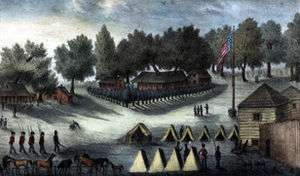
Florida became the 27th state in 1845. On January 18, 1849, Tampa was officially incorporated as the "Village of Tampa". Tampa was home to 185 civilians, or 974 total residents including military personnel, in 1850.[33][34] Tampa was reincorporated as a town on December 15, 1855.[35]

Civil War and Reconstruction
During the Civil War, Florida seceded along with most of the southern states to form the Confederate States of America, and Fort Brooke was manned by Confederate troops. Martial law was declared in Tampa in January 1862, and Tampa's city government ceased to operate for the duration of the war.[36]
In 1861, the Union Navy set up a blockade around many southern ports to cut off the Confederacy, and several ships were stationed near the mouth of Tampa Bay.[37][38][39] The Battle of Fort Brooke on October 16 and the Battle of Ballast Point on October 18, 1863 damaged the Confederates, with Union troops destroying Confederate blockade runners.[40] The Civil War ended in April 1865 with a Confederate defeat.
In May 1865, federal troops arrived in Tampa to occupy the fort and the town as part of Reconstruction. They remained until August 1869.
Tampa was a fishing village with very few people and little industry, and limited prospects for development. Tampa's chronic yellow fever epidemics, borne by mosquitoes from the swampland, were widespread during the late 1860s and 1870s, and many residents left.[41]
In 1869, residents voted to abolish the city of Tampa government.[42] The population of "Tampa Town" was below 800 by 1870, and had fallen further by 1880. Fort Brooke was decommissioned in 1883, and except for two cannons displayed on the University of Tampa campus, all traces of the fort are gone.
1880s economic prosperity

In the mid-1880s, Tampa's fortunes took several sudden turns for the better. First, phosphate was discovered in the Bone Valley region southeast of Tampa in 1883. The mineral, vital for the production of fertilizers and other products, was soon being shipped out from the Port of Tampa in great volume. Tampa is still a major phosphate exporter.
The discovery of phosphate, the arrival of Plant's railroad, and the founding of Ybor City and West Tampa—all in the mid-1880s—were crucial to Tampa's development. The once-struggling village of Tampa became a bustling boomtown almost overnight, and had grown into one of the largest cities in Florida by 1900.[43]
Plant's railroad
Henry B. Plant's narrow-gauge South Florida Railroad reached Tampa and its port in late 1883, finally connecting the small town to the nation's railroad system after years of efforts by local leaders. Previously, Tampa's overland transportation links had consisted of sandy roads stretching across the Florida countryside. Plant's railroad made it much easier to get goods in and out of the Tampa Bay area. Phosphate and commercial fishing exports could be sent north by rail[44] and many new products were brought into the Tampa market, along with the first tourists.

Ybor's cigars

The new railroad link enabled another important industry to come to Tampa. In 1885, the Tampa Board of Trade enticed Vicente Martinez Ybor to move his cigar manufacturing operations to Tampa from Key West. Proximity to Cuba made importation of "clear Havana tobacco" easy by sea, and Plant's railroad made shipment of finished cigars to the rest of the US market easy by land.[43]
Since Tampa was still a small town at the time (population less than 5000), Ybor built hundreds of small houses around his factory to accommodate the immediate influx of mainly Cuban and Spanish cigar workers. Ybor City's factories rolled their first cigars in 1886, and many different cigar manufacturers moved their operations to town in ensuing years. Many Italian and a few eastern European Jewish immigrants arrived starting in the late 1880s, opening businesses and shops that catered to cigar workers. By 1900, over 10,000 immigrants had moved to the neighborhood. Several thousand more Cuban immigrants built West Tampa, another cigar-centric suburb founded a few years later by Hugh MacFarlane. Between them, two "Latin" communities combined to exponentially expand Tampa's population, economic base, and tax revenues, as Tampa became the "Cigar Capital of the World".[45]

Early 20th century
During the first few decades of the 20th century, the cigar-making industry was the backbone of Tampa's economy. The factories in Ybor City and West Tampa made an enormous number of cigars—in the peak year of 1929, over 500,000,000 cigars were hand rolled in the city.[46]
In 1904, a local civic association of local businessmen dubbed themselves Ye Mystic Krewe of Gasparilla (named after local mythical pirate Jose Gaspar), and staged an "invasion" of the city followed by a parade. With a few exceptions, the Gasparilla Pirate Festival has been held every year since.[47]
Bolita and organized crime
Beginning in the late 19th century, illegal bolita lotteries were very popular among the Tampa working classes, especially in Ybor City. In the early 1920s, this small-time operation was taken over by Charlie Wall, the rebellious son of a prominent Tampa family, and went big-time. Bolita was able to openly thrive only because of kick-backs and bribes to key local politicians and law enforcement officials, and many were on the take.[48]
Profits from the bolita lotteries and Prohibition-era bootlegging led to the development of several organized crime factions in the city. Charlie Wall was the first major boss, but various power struggles culminated in consolidation of control by Sicilian mafioso Santo Trafficante, Sr., and his faction in the 1950s. After his death in 1954 from cancer, control passed to his son Santo Trafficante, Jr., who established alliances with families in New York City and extended his power throughout Florida and into Batista-era Cuba.[49][50]
The era of rampant and open corruption ended in the 1950s, when the Estes Kefauver's traveling organized crime hearings came to town and were followed by the sensational misconduct trials of several local officials. Although many of the worst offenders in government and the mob were not charged, the trials helped to end the sense of lawlessness which had prevailed in Tampa for decades.[48]

Mid to late 20th century
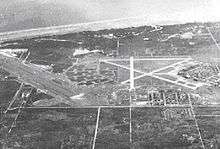
Tampa grew considerably as a result of World War II. Prior to the United States' involvement in the conflict, construction began on MacDill Field, the predecessor of present-day MacDill Air Force Base. MacDill Field served as a main base for Army Air Corps and later Army Air Forces operations just before and during World War II, with multiple auxiliary airfields around the Tampa Bay area and surrounding counties. At the end of the war, MacDill remained as an active military installation while the auxiliary fields reverted to civilian control. Two of these auxiliary fields would later become the present day Tampa International Airport and St. Petersburg-Clearwater International Airport. With the establishment of an independent U.S. Air Force in 1947, MacDill Field became MacDill AFB.
During the 1950s and 1960s Tampa saw record-setting population growth that has not been seen since. This amazing growth spurred major expansion of the city's highways and bridges bringing thousands into the city and creating endless possibilities for Tampa business owners who welcomed tourists and new citizens alike into their neighborhoods. It was during this time period in the city's history that two of the most popular tourist attractions in the area were developed – Busch Gardens and Lowry Park. Many of the well-known institutions that play an important role in the economic development of the city were established during this time period.[51]
The University of South Florida was established in North Tampa in 1956 and opened for students in September 1960.[52] The school spurred the construction of several residential and commercial development in the previously agriculture-dominated area around the new campus. Overall, Tampa continued to expand away from the city center during the 1960s as new hospitals, schools, churches and subdivisions all began appearing to accommodate the growth. Many business offices began moving away from the traditional downtown office building into more convenient neighborhood office plazas.[51]
In 1970, the Census Bureau reported city's population as 80.0% white and 19.7% black.[53]
Four attempts have been made to consolidate the municipal government of the city of Tampa with the county government of Hillsborough County (1967, 1970, 1971, and 1972), all of which failed at the ballot box; the greatest loss was also the most recent attempt in 1972, with the final tally being 33,160 (31%) in favor and 73,568 (69%) against the proposed charter.[54]
The biggest recent growth in the city was the development of New Tampa, which started in 1988 when the city annexed a mostly rural area of 24 square miles (62 km2) between I-275 and I-75.
East Tampa, historically a mostly black community, was the scene of several race riots during and for some time after the period of racial segregation, mainly due to problems between residents and the Tampa Police Department.
Geography
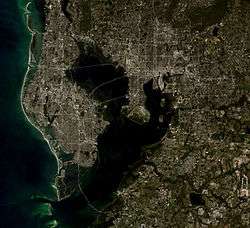
Topography
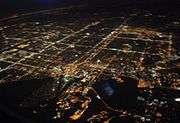
According to the United States Census Bureau, the city has a total area of 170.6 square miles (442 km2) including 112.1 square miles (290 km2) of land and 58.5 square miles (151.5 km2) (34.31%) of water. The highest point in the city is only 48 feet (15 m). Tampa is bordered by two bodies of water, Old Tampa Bay and Hillsborough Bay, both of which flow together to form Tampa Bay, which in turn flows into the Gulf of Mexico. The Hillsborough River flows out into Hillsborough Bay, passing directly in front of Downtown Tampa and supplying Tampa's main source of fresh water. Palm River is a smaller river flowing from just east of the city into McKay Bay, which is a smaller inlet, sited at the northeast end of Hillsborough Bay[55] Tampa's geography is marked by the Interbay Peninsula which divides Hillsborough Bay (the eastern) from Old Tampa Bay (the western).
Climate
Tampa's climate displays characteristics of a tropical climate, but is situated on the southern fringe of the humid subtropical climate (Köppen Cfa) zone. Tampa's climate generally features hot summer days with frequent thunderstorms in the summer (rain is less frequent in the fall and winter), and a threat of a light winter freeze from November 15 through March 5 caused by occasional cold fronts from the north. Average highs range from 70 to 90 °F (21 to 32 °C) year round, and lows 52 to 76 °F (11 to 24 °C).[56] Tampa's official recorded high has never hit 100 °F (37.8 °C) – the all-time record high temperature is 99 °F (37 °C), recorded on June 5, 1985.[56]

Because of Tampa Bay, Tampa is split between two USDA climate zones. According to the 2012 USDA Plant Hardiness Zone Map, Tampa is listed as USDA zone 9b north of Kennedy Boulevard away from the bay and 10a south of Kennedy Boulevard and along the bay, Zone 10a is about the northern limit of where coconut palms and royal palms can be grown, although some specimens do grow in northern Tampa. Southern Tampa has much more tropical foliage than the northern parts of the city.
Summer
Temperatures are warm to hot from around mid-May through mid-October, which roughly coincides with the rainy season. Summertime weather is very consistent from June through September, with daytime highs near 90 °F (32 °C), lows in the mid-70s °F (23–24 °C), and high humidity.
Afternoon thunderstorms, usually generated by the interaction of the Gulf and Atlantic sea breezes, are such a regular occurrence during the summer that the Tampa Bay area is recognized as the "Lightning Capital of North America". Every year, Florida averages 10 deaths and 30 injuries from lightning strikes, with several of these usually occurring in or around Tampa.[57] Because of the frequent summer thunderstorms, Tampa has a pronounced wet season, receiving an average of 26.1 inches (663 mm) of rain from June to September but only about 18.6 inches (472 mm) during the remaining eight months of the year. The historical averages during the late summer, especially September, are augmented by passing tropical systems, which can easily dump many inches of rain in one day. Tropical Storm Debby in 2012 dropped 8.57 inches (218 mm) of rain at Tampa International Airport on June 24, 2012 and amounts up to 10.36 inches (263 mm) was reported by a CoCoRaHS observer in NW Tampa.[58] Outside of the summer rainy season, most of the area's precipitation is delivered by the occasional passage of a weather front.[56]
The regular summertime afternoon thundershowers occasionally intensify into a severe thunderstorm, bringing heavy downpours, frequent lightning, strong straight-line winds, and sometimes hail.
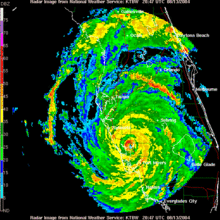
Tropical systems
Though it is affected by tropical storms every few years and threatened by tropical systems almost annually, Tampa has not taken a direct hit from a hurricane since 1921.[59] That seemed about to change in 2004, when Hurricane Charley was forecast to make landfall near downtown Tampa, with potentially devastating effects for the entire region. The danger prompted one of the largest evacuations in state history. But Charley never reached Tampa Bay. After paralleling Florida's southwest coastline, the storm swerved to the east and slammed into Punta Gorda instead.
Winter
In the winter, average temperatures range from the low to mid 70s °F (21–24 °C) during the day to the low to mid 50s °F (10–13 °C) at night. However, sustained colder air pushes into the area on several occasions every winter, dropping the highs and lows to 15 °F (8 °C) or more below the seasonal averages for several days at a time. The temperature can fall below freezing an average of 2 to 3 times per year, though this does not occur every season.[60]
Since the Tampa area is home to a diverse range of freeze-sensitive agriculture and aquaculture, hard freezes, although very infrequent, are a major concern. Since Tampa has some characteristics of a tropical climate, hard freezes (defined as below 28 °F (−2.2 °C)) happen rarely (every 5 to 20 years depending on location). The last officially recorded freeze at Tampa International Airport took place on the morning of January 13, 2011, when the temperature dropped to 31 °F (−1 °C).[61]
The lowest temperature ever recorded in Tampa was 18 °F (−8 °C) on December 13, 1962.[56] The last measurable snow in Tampa fell on January 19, 1977, with a total accumulation of 0.2 inches (0.5 cm). Three major freezes occurred in the 1980s: in January 1982, January 1985, and December 1989. The losses suffered by farmers forced many to sell off their citrus groves, which helped fuel a boom in subdivision development in the 1990s and 2000s.[62][63]
In January 2010, a prolonged cold snap was the longest stretch of cold weather in the history of Tampa.[64] Temperatures did not get above 49 °F (9.4 °C) for 5 days and there were freezes every night in northern Tampa for a week straight, causing significant damage to tropical foliage.
| Climate data for Tampa, Florida (Tampa Int'l), 1981−2010 normals,[lower-alpha 1] extremes 1890−present[lower-alpha 2] | |||||||||||||
|---|---|---|---|---|---|---|---|---|---|---|---|---|---|
| Month | Jan | Feb | Mar | Apr | May | Jun | Jul | Aug | Sep | Oct | Nov | Dec | Year |
| Record high °F (°C) | 86 (30) |
88 (31) |
92 (33) |
93 (34) |
98 (37) |
99 (37) |
98 (37) |
98 (37) |
96 (36) |
95 (35) |
92 (33) |
86 (30) |
99 (37) |
| Mean maximum °F (°C) | 81.1 (27.3) |
82.3 (27.9) |
85.2 (29.6) |
88.2 (31.2) |
93.3 (34.1) |
94.8 (34.9) |
94.8 (34.9) |
94.4 (34.7) |
93.5 (34.2) |
90.8 (32.7) |
86.2 (30.1) |
82.4 (28) |
96.0 (35.6) |
| Average high °F (°C) | 69.9 (21.1) |
72.5 (22.5) |
76.3 (24.6) |
81.0 (27.2) |
87.2 (30.7) |
89.6 (32) |
90.1 (32.3) |
90.2 (32.3) |
88.9 (31.6) |
84.3 (29.1) |
78.0 (25.6) |
72.0 (22.2) |
81.7 (27.6) |
| Average low °F (°C) | 51.6 (10.9) |
54.4 (12.4) |
58.2 (14.6) |
63.0 (17.2) |
69.7 (20.9) |
74.8 (23.8) |
75.9 (24.4) |
76.2 (24.6) |
74.5 (23.6) |
68.0 (20) |
60.3 (15.7) |
54.2 (12.3) |
65.1 (18.4) |
| Mean minimum °F (°C) | 32.6 (0.3) |
37.0 (2.8) |
41.4 (5.2) |
48.8 (9.3) |
59.6 (15.3) |
68.3 (20.2) |
70.8 (21.6) |
71.7 (22.1) |
67.5 (19.7) |
53.2 (11.8) |
44.6 (7) |
36.1 (2.3) |
30.2 (−1) |
| Record low °F (°C) | 21 (−6) |
22 (−6) |
29 (−2) |
38 (3) |
49 (9) |
53 (12) |
63 (17) |
66 (19) |
54 (12) |
40 (4) |
23 (−5) |
18 (−8) |
18 (−8) |
| Average rainfall inches (mm) | 2.23 (56.6) |
2.81 (71.4) |
3.03 (77) |
2.03 (51.6) |
2.10 (53.3) |
6.68 (169.7) |
7.07 (179.6) |
7.77 (197.4) |
6.30 (160) |
2.26 (57.4) |
1.55 (39.4) |
2.47 (62.7) |
46.3 (1,176) |
| Average rainy days (≥ 0.01 inch) | 6.8 | 6.6 | 6.6 | 4.9 | 5.5 | 12.7 | 15.9 | 16.0 | 12.2 | 6.5 | 5.1 | 5.8 | 104.6 |
| Average relative humidity (%) | 74.9 | 73.0 | 71.8 | 69.0 | 69.8 | 74.4 | 76.6 | 78.4 | 77.6 | 74.2 | 75.0 | 75.0 | 74.1 |
| Mean monthly sunshine hours | 199.9 | 202.7 | 267.5 | 299.1 | 314.5 | 277.8 | 265.3 | 249.5 | 223.0 | 233.9 | 201.7 | 191.6 | 2,926.5 |
| Percent possible sunshine | 61 | 65 | 72 | 78 | 75 | 67 | 62 | 61 | 60 | 66 | 62 | 60 | 66 |
| Source: NOAA (relative humidity and sun 1961−1990)[65][66][67] Weather Channel[68] | |||||||||||||
Cityscape

Neighborhoods
The city is divided into many neighborhoods, many of which were towns and unincorporated communities annexed by the growing city. Generally, the city is divided into the following areas: Downtown Tampa, New Tampa, West Tampa, East Tampa, North Tampa, and South Tampa. Well-known neighborhoods include Ybor City, Forest Hills, Ballast Point, Sulphur Springs, Seminole Heights, Tampa Heights, Palma Ceia, Hyde Park, Davis Islands, Tampa Palms, College Hill, and non-residential areas of Gary and the Westshore Business District.
Architecture
Tampa displays a wide variety of architectural designs and styles. Most of Tampa's high rises demonstrate Post-modern architecture. The design for the renovated Tampa Museum of Art, displays Post-modern architecture, while the city hall and the Tampa Theatre belong to Art Deco architecture. The Tampa mayor Pam Iorio made the redevelopment of Tampa's downtown, especially residential development, a priority.[69] Several residential and mixed-development high-rises have been constructed. Another of Mayor Iorio's initiatives was the Tampa Riverwalk, a mixed use path along the Hillsborough River in downtown and Channelside (Channelside was recently approved[70] to undergo major renovations by Tampa Bay Lightning owner Jeff Vinik along with other investors). Several museums are part of the plan, including new homes for the Tampa Bay History Center, the Tampa Children's Museum, and the Tampa Museum of Art.[71] Mayor Bob Buckhorn has continued these developments.
Tampa is the site of several skyscrapers. Overall, there are 18 completed buildings that rise over 250 feet (76 m) high. The city also has 69 high-rises,[72] second only to Miami in the state of Florida. The tallest building in the city is 100 North Tampa, formerly the AmSouth Building, which rises 42 floors and 579 feet (176 m) in Downtown Tampa.[73] The structure was completed in 1992, and is the tallest building in Florida outside of Miami and Jacksonville.[73]
-
100 North Tampa (1992)
-

Bank of America Plaza (1986)
-

One Tampa City Center (1981)
-

SunTrust Financial Centre (1992)
-
The Element (2009)
-

Park Tower (1972)
-

Rivergate Tower (1988)
-
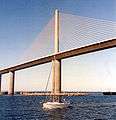
The Sunshine Skyway Bridge (1987)
Landmarks
The Sulphur Springs Water Tower, a landmark in Sulphur Springs section of the city, dates back to the late 1920s. This boom period for Florida also saw the construction of an ornate movie palace, the Tampa Theatre, a Mediterranean revival on Davis Islands, and Bayshore Boulevard, which borders Hillsborough Bay from downtown Tampa to areas in South Tampa. The road has a 6-mile (10 km) continuous sidewalk on the eastern end, the longest in the world.[74][75]
The Ybor City District is home to several buildings on the National Register of Historic Places and has been declared a National Historic Landmark. Notable structures include El Centro Español de Tampa, Centro Asturiano de Tampa and other social clubs built in the early 1900s.
Babe Zaharias Golf Course in the Forest Hills area of Tampa has been designated a Historical Landmark by the National Register of Historic Places. It was bought in 1949 by the famous 'Babe', who had a residence nearby, and closed upon her death. In 1974, the city of Tampa opened the golf course to the public.[76] The Story of Tampa, a public painting by Lynn Ash, is a 4-by-8-foot (1.2 m × 2.4 m) oil on masonite mural that weaves together many of the notable aspects of Tampa's unique character and identity. It was commissioned in 2003 by the city's Public Art Program and can be found in the lobby of the Tampa Municipal Office Building.[77] Park Tower (originally the First Financial Bank of Florida) is the first substantial skyscraper in downtown Tampa. Completed in 1973, it was the tallest skyscraper in Tampa until the completion of One Tampa City Center in 1981.[78] The Rivergate building, a cylindrical building known as the "Beer Can building", was featured in the movie "The Punisher".
Spanning the southern part of Tampa Bay, is the massive steel-span Sunshine Skyway Bridge.
Tampa is home to the Bro Bowl, one of the last remaining skateparks built during skateboarding's "Golden Era" in the 1970s. It opened in 1979 and was constructed by Tampa Parks and Recreation. It was the first public skatepark to be constructed in Florida and the third on the East Coast.
Demographics
| Historical population | |||
|---|---|---|---|
| Census | Pop. | %± | |
| 1850 | 974 | — | |
| 1870 | 796 | — | |
| 1880 | 720 | −9.5% | |
| 1890 | 5,532 | 668.3% | |
| 1900 | 15,839 | 186.3% | |
| 1910 | 37,782 | 138.5% | |
| 1920 | 51,608 | 36.6% | |
| 1930 | 101,161 | 96.0% | |
| 1940 | 108,391 | 7.1% | |
| 1950 | 124,681 | 15.0% | |
| 1960 | 274,970 | 120.5% | |
| 1970 | 277,714 | 1.0% | |
| 1980 | 271,523 | −2.2% | |
| 1990 | 280,015 | 3.1% | |
| 2000 | 303,447 | 8.4% | |
| 2010 | 335,709 | 10.6% | |
| Est. 2015 | 369,075 | [79] | 9.9% |
| source:[80][81][82][83] | |||
| Tampa demographics | |||
|---|---|---|---|
| 2010 Census | Tampa | Hillsborough County | Florida |
| Total population | 335,709 | 1,229,226 | 18,801,310 |
| Population, percent change, 2000 to 2010 | +10.6% | +23.1% | +17.6% |
| Population density | 2,960.2/sq mi | 1,204.9/sq mi | 350.6/sq mi |
| White or Caucasian (including White Hispanic) | 62.9% | 71.3% | 75.0% |
| (Non-Hispanic White or Caucasian) | 46.3% | 53.7% | 57.9% |
| Black or African-American | 26.2% | 16.7% | 16.0% |
| Hispanic or Latino (of any race) | 23.1% | 24.9% | 22.5% |
| Asian | 3.4% | 3.4% | 2.4% |
| Native American or Native Alaskan | 0.4% | 0.4% | 0.4% |
| Pacific Islander or Native Hawaiian | 0.1% | 0.1% | 0.1% |
| Two or more races (Multiracial) | 3.2% | 3.1% | 2.5% |
| Some Other Race | 3.8% | 5.0% | 3.6% |
As of 2000, the largest European ancestries in the city were German (9.2%), Irish (8.4%), English (7.7%), Italian (5.6%), and French (2.4%).[12]
As of 2010, there were 157,130 households out of which 13.5% were vacant. In 2000, 27.6% households had children under the age of 18 living with them, 36.4% were married couples living together, 16.1% had a female householder with no husband present, and 42.9% were non-families. 33.7% of all households were made up of individuals and 10.2% had someone living alone who was 65 years of age or older. The average household size was 2.36 and the average family size was 3.07.
In 2000, the city's population was spread out with 24.6% under the age of 18, 10.0% from 18 to 24, 32.3% from 25 to 44, 20.5% from 45 to 64, and 12.5% who were 65 years of age or older. The median age was 34.7 years old. For every 100 females there were 95.3 males. For every 100 females age 18 and over, there were 92.1 males.
In 2006, the median income for a household in the city was $39,602, and the median income for a family was $45,823. Males had a median income of $40,461 versus $29,868 for females. The per capita income for the city was $26,522. 20.1% of the population and 16.4% of families were below the poverty line. 31.0% of those under the age of 18 and 13.6% of those 65 and older are living below the poverty level.
As of 2000, those who spoke only English at home accounted for 77.4% of all residents, while 22.6% spoke other languages in their homes. The most significant was Spanish speakers who made up 17.8% of the population, while French came up as the third most spoken language, which made up 0.6%, and Italian was at fourth, with 0.6% of the population.[84]
There is a large gay population and a gay cultural center known as the GaYbor District.
Religion
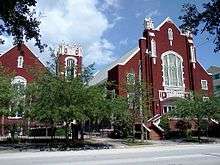

Communities of faith have organized in Tampa from 1846, when a Methodist congregation established the city's first church,[85] to 1939, when a 21-year-old Billy Graham began his career as a spiritual evangelist and preacher on downtown's Franklin Street,[86] and through to today. Among Tampa's noteworthy religious structures are Sacred Heart Catholic Church, a 1905 downtown landmark noted for its soaring, Romanesque revival construction in granite and marble with German-crafted stained glass windows,[87] the distinctive rock and mortar St. James Episcopal House of Prayer, listed with the U.S. historic registry,[88] and the St. Paul AME church, which has seen the likes of Dr. Martin Luther King, Jr.,[86] and President Bill Clinton speak from its pulpit.[89] The later two have been designated by the city government as Local Landmark Structures.[90]
Tampa's religious community includes a broad representation of Christian denominations, including those above, and Presbyterian, Lutheran, Christian Science, Church of God, United Church of Christ, Philippine Independent Church, Unitarian Universalist, Metropolitan Community Church, Seventh-day Adventist, Eastern Orthodox (Greek, Coptic, Syrian, and OCA), various Pentecostal movements, Anglicans, the Quakers, Jehovah's Witnesses, and The Church of Jesus Christ of Latter-day Saints. There is also at least one congregation of Messianic Jews in Tampa.[91] In addition there is a Korean Baptist church.,[92][93] as well as a Mennonite Church, several Haitian Churches, and a Vietnamese Baptist Church.[94] Tampa also has several Jewish synagogues practicing Orthodox, Conservative, and Reform.[95] In addition, there is a small Zoroastrian community present in Tampa.[96]
Around the city are located a handful of mosques for followers of Islam, as well as a Tibetan-style Buddhist temple, a Thai Buddhist Wat,[97] and local worship centers for the Sikh,[98] Hindu and Bahá'í faiths. The Church of Scientology, based in nearby Clearwater, maintains a location for its members in Tampa.[99]
Overall, Tampa is 50th out of the largest 51 metropolitan area in the percentage of the populace that attends religious services of any kind.[100]
Economy
Finance, retail, healthcare, insurance, shipping by air and sea, national defense, professional sports, tourism, and real estate all play a vital role in the area's economy.[101] Hillsborough County alone has an estimated 740,000 employees, a figure which is projected to increase to 922,000 by 2015.[101] Several large corporations, such as banks and telecommunications companies, maintain regional offices in Tampa.
Several Fortune 1000 companies are headquartered in the metropolitan area,[102] including OSI Restaurant Partners, WellCare, TECO Energy, and Raymond James Financial.
| Employer | Employees | Industry |
|---|---|---|
| BayCare Health System | 19,600 | Healthcare |
| Publix Super Market | 13,800 | Retail |
| HCA West Florida | 13,150 | Healthcare |
| Frontier Communications | 9,950 | Telecommunications |
| Tampa General Hospital | 6,600 | Healthcare |
| Wal-Mart | 5,800 | Retail |
| Florida Hospital | 5,100 | Healthcare |
| JPMorgan Chase & Co. | 5,000 | Finance |
| Moffitt Cancer Center | 4,300 | Healthcare |
| Citi | 4,000 | Finance |
Downtown Tampa is undergoing significant development and redevelopment in line with a general national trend toward urban residential development. As of April 2007, the Tampa Downtown Partnership noted development proceeding on 20 residential, hotel, and mixed-use projects.[104] Many of the new downtown developments are nearing completion in the midst of a housing market slump, which has caused numerous projects to be delayed or revamped, and some of the 20 projects TDP lists have not broken ground and are being refinanced. Nonetheless several developments are nearing completion, which city leaders hope will make downtown into a 24-hour neighborhood instead of 9 to 5 business district.[105] As of 2010, Tampa residents faced a decline in rent of 2%. Nationally rent had decreased 4%.[106] The Tampa Business Journal found Tampa to be the number two city for real estate investment in 2014.[107]
Tampa's port is now the seventh largest in the nation and Florida's largest tonnage port, handling nearly half of all seaborne commerce that passes through the state. Tampa currently ranks second in the state behind Miami in terms of cruise ship travel. Besides smaller regional cruise ships such as Yacht Starship and SunCruz Casino, Tampa also serves as a port of call for three cruise lines: Holland America's MS Ryndam, Royal Caribbean's Grandeur of the Seas and Radiance of the Seas, and Carnival's Inspiration and Legend.[108]
The main server farm for Wikipedia and other Wikimedia Foundation projects is located in Tampa.[109]
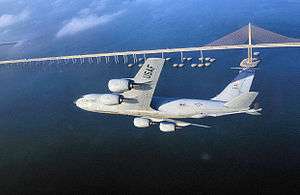
MacDill Air Force Base remains a major employer as the parent installation for over 15,000 active uniformed military, Department of Defense (DoD) civil service and DoD contractor personnel in the Tampa Bay area. A significant majority of the civil service and contractor personnel are, in fact, themselves retired career military personnel. In addition to the 6th Air Mobility Wing, which is "host wing" for the base, MacDill is also home to Headquarters, United States Central Command (USCENTCOM), Headquarters, United States Special Operations Command (USSOCOM), the 927th Air Refueling Wing, Headquarters, United States Marine Forces Central Command (USMARCENT), Headquarters, United States Special Operations Command Central (USSOCCENT), and numerous other military activities of the active and reserve components of the armed forces.
Since the year 2000, Tampa has seen a notable upsurge in high-market demand from consumers, signaling more wealth concentrated in the area.[110]
Arts and culture
Arts and entertainment
Tampa is home to a variety of stage and performing arts venues and theaters, including The David A. Straz Jr. Center for the Performing Arts, Tampa Theatre, Gorilla Theatre, and the MidFlorida Credit Union Amphitheatre next to the Florida State Fairgrounds.
Performing arts companies and organizations which call Tampa home include The Florida Orchestra, Opera Tampa, Jobsite Theater, The Master Chorale of Tampa Bay, Stageworks Theatre, Spanish Lyric Theater, Tampa Bay Opera, and the Tampa Bay Symphony.
Current popular nightlife districts include Channelside, Ybor City, SoHo, International Plaza and Bay Street, and Seminole Hard Rock. Downtown Tampa also contains some nightlife, and there are more clubs/bars to be found in other areas of the city. Tampa is rated sixth on Maxim magazine's list of top party cities.[111]
The area has become a "de facto" headquarters of professional wrestling, with many pros living in the area.[112][113][114][115] WWE's developmental territory, Florida Championship Wrestling, is also based in Tampa.
Tampa is home to several death metal bands, an extreme form of heavy metal music that evolved from thrash metal. Many of the genre's pioneers and foremost figures are based in and around the city. Chief among these are Deicide, Six Feet Under, Obituary, Cannibal Corpse, and Morbid Angel. The Tampa scene grew with the birth of Morrisound Recording, which established itself as an international recording destination for metal bands.[116]
The underground rock band, the Baskervils, got their start in Tampa. They played the Tampa Bay area between 1994 and 1997 and then moved to New York City. Underground hip-hop group Equilibrium is based out of Tampa, as well as the Christian metalcore band, Underoath.
In 2009, the new Frank Wildhorn musical Wonderland: Alice's New Musical Adventure hosted its world premiere at the Straz Center.
Museums
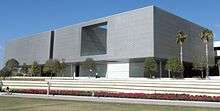
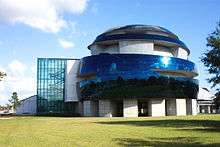
The Tampa area is home to a number of museums that cover a wide array of subjects and studies. These include the Museum of Science & Industry (MOSI), which has several floors of science-related exhibits plus the only domed IMAX theater in Florida and a planetarium; the Tampa Museum of Art; the USF Contemporary Art Museum; the Tampa Bay History Center; the Tampa Firefighters Museum; the Henry B. Plant Museum; and Ybor City Museum State Park. Permanently docked in downtown's Channel District is the SS American Victory, a former World War II Victory Ship which is now used as a museum ship.
Cuisine
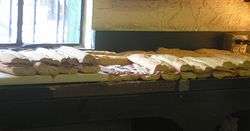
Tampa has a diverse culinary scene from small cafes and bakeries to bistros and farm-to-table restaurants. The food of Tampa has a history of Cuban, Spanish, Floribbean and Italian cuisines. There are also many Colombian cuisine, Puerto Rican cuisine, Vietnamese cuisine and Barbecue restaurants. Seafood is also very popular in Tampa, and Greek cuisine is prominent in the area, including around Tarpon Springs. Food trucks in Tampa, Florida are popular and the area holds the record for the world's largest food truck rally. In addition to Ybor, the areas of Seminole Heights and South Tampa are known for their restaurants.
Tampa is most famous though for the Cuban sandwich and Deviled crab. Tampa is considered to be where the Cuban sandwich started, though it is disputed by Miami. Historian Andrew Huse states that "the old 'mixtos' coalesced into something more distinct – the Cuban sandwiches we know and love – an original Tampa creation."[117] In April 2012, the "Historic Tampa Cuban Sandwich" was designated as the "signature sandwich of the city of Tampa" by Tampa's city council.[118] Tampa's Cuban sandwiches are different from other regional versions because Genoa salami is usually added to Cubans in the Tampa area, which derived from Italian immigrants living next to Cubans and Spaniards in Ybor City.[119][120]
Tampa is also where many restaurant chains have either started out or are headquartered, such as Outback Steakhouse, Melting Pot, Front Burner Brands, Carrabba's, Fleming's Prime Steakhouse & Wine Bar, Bonefish Grill, Columbia Restaurant, Checkers and Rally's, Taco Bus, and PDQ.
Tourism and recreation

The city of Tampa operates over 165 parks and beaches covering 2,286 acres (9.25 km2) within city limits; 42 more in surrounding suburbs covering 70,000 acres (280 km2), are maintained by Hillsborough County. These areas include the Hillsborough River State Park, just northeast of the city. Tampa is also home to a number of attractions and theme parks, including Busch Gardens Tampa Bay, Adventure Island, Lowry Park Zoo, and Florida Aquarium.
Lowry Park Zoo features over 2,000 animals, interactive exhibits, rides, educational shows and more. The zoo serves as an economic, cultural, environmental and educational anchor in Tampa.
Big Cat Rescue is one of the largest accredited sanctuaries in the world dedicated entirely to abused and abandoned big cats.[121] It is home to about 80 lions, tigers, bobcats, cougars and other species, most of whom have been abandoned, abused, orphaned, saved from being turned into fur coats, or retired from performing acts.[121] They have a variety of different tours available.[122]
Busch Gardens Tampa Bay is a 335-acre (1.36 km2) Africa-themed park located near the University of South Florida. It features many thrilling roller coasters, for which it is known, including Sheikra, Montu, Gwazi and Kumba. Visitors can also view and interact with a number of African wildlife. Adventure Island is a 30-acre (12 ha) water park adjacent to Busch Gardens.
The Florida Aquarium is a 250,000 sq ft (23,000 m2) aquarium located in the Channel District. It hosts over 20,000 species of aquatic plants and animals. It is known for its unique glass architecture. Adjacent to the Aquarium is the SS American Victory, a World War II Victory ship preserved as a museum ship.
The Tampa Bay History Center is a museum located in the Channel District. It boasts over 60,000 sq ft (5,600 m2) of exhibits through 12,000 years. Theaters, map gallery, research center and museum store.
Well-known shopping areas include International Plaza and Bay Street, WestShore Plaza, SoHo district, and Hyde Park Village.[123] Palma Ceia is also home to a shopping district, called Palma Ceia Design District.[124] Previously, Tampa had also been home to the Floriland Mall (now an office park), Tampa Bay Center (demolished and replaced with the new Tampa Bay Buccaneers training facility, known as "One Buc Place"), and East Lake Square Mall (now an office park).
The Tampa Port Authority currently operates three cruise ship terminals in Tampa's Channel District. The Port of Tampa is the year-round home port for Carnival Cruise Lines' MS Carnival Inspiration and MS Carnival Legend. In 2010 Tampa will also be a seasonal port for Holland America Line's MS Ryndam, as well as Royal Caribbean International's MS Grandeur of the Seas and MS Radiance of the Seas.[125] A fourth company, Norwegian Cruise Line, has announced plans to sail out of Tampa for the first time. The 2,240 passenger MS Norwegian Star will be Tampa's largest cruise ship when it debuts a seasonal schedule in 2011. Cruise itineraries from Tampa include stops in the Eastern and Western Caribbean islands, Honduras, Belize, and Mexico.[126]
Events
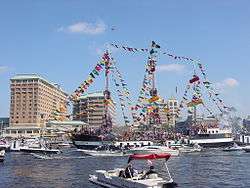
Perhaps the most well known and anticipated events are those from Tampa's annual celebration of "Gasparilla", particularly the Gasparilla Pirate Festival, a mock pirate invasion held since 1904 in late January or early February. Often referred to as Tampa's "Mardi Gras", the invasion flotilla led by the pirate ship, Jose Gasparilla, and subsequent parade draw over 400,000 attendees, contributing tens of millions of dollars to the city's economy. Beyond the initial invasion, numerous Gasparilla festivities take place each year between January and March, including the Gasparilla Children's Parade, the more adult-oriented Sant'Yago Knight Parade, the Gasparilla Distance Classic, Gasparilla Festival of the Arts, and the Gasparilla International Film Festival, among other pirate themed events.[127]
Other notable events include the Outback Bowl, which is held New Year's Day at Raymond James Stadium. Each February, The Florida State Fair brings crowds from across the state, while "Fiesta Day" celebrates Tampa's Cuban, Spanish, German, Italian, English, Irish, Jewish, and African-Cuban immigrant heritage. The India International Film Festival (IIFF) of Tampa Bay also takes place in February. In April the MacDill Air Fest entertains as one of the largest military air shows in the U.S. Guavaween, a nighttime street celebration infuses Halloween with the Latin flavor of Ybor City.[128] Downtown Tampa hosts the largest anime convention in Florida, Metrocon, a three-day event held in either June or July at the Tampa Convention Center.[129] Ybor also hosts "GaYbor Days", an annual street party in the GLBT-friendly GaYbor district.[130] The Tampa International Gay and Lesbian Film Festival, held annually since 1989, is the city's largest film festival event,[131] and one of the largest independent gay film festivals in the country.[132]
Tampa hosted the 2012 Republican National Convention and the 15th International Indian Film Academy Awards in April 2014.[133][134]
Sports
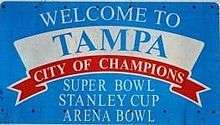
Tampa is represented by teams in three major professional sports leagues: the National Football League, the National Hockey League, and Major League Baseball. The NFL's Tampa Bay Buccaneers and the NHL's Tampa Bay Lightning call Tampa home, while the Tampa Bay Rays of the MLB play across the bay in St. Petersburg. As indicated by their names, these teams, plus several other sports teams, represent the entire Tampa Bay metropolitan area.
Football
The Tampa Bay Buccaneers began in 1976 as an expansion team of the NFL. They struggled at first, losing their first 26 games in a row to set a league record for futility. After a brief taste of success in the late 1970s, the Bucs again returned to their losing ways, and at one point lost 10+ games for 12 seasons in a row. The hiring of Tony Dungy in 1996 started an improving trend that eventually led to the team's victory in Super Bowl XXXVII in 2003 under coach Jon Gruden.
Tampa has hosted four Super Bowls: Super Bowl XVIII (1984), Super Bowl XXV (1991), Super Bowl XXXV (2001), and Super Bowl XLIII (2009). The first two events were held at Tampa Stadium, and the other two at Raymond James Stadium.
The Tampa Bay Storm of the Arena Football League moved to Tampa from Pittsburgh in 1991 and won ArenaBowl V that year. They have won 4 more ArenaBowls since then: ArenaBowl VII, IX, X, and XVII, and also appeared in ArenaBowl I, III, XII and XXIII.[135] They are tied for the most Arena Bowl titles.
Tampa was also home to the Tampa Bay Bandits of the United States Football League. The Bandits were moderately successful, making the playoffs two of the three years they existed before the league folded in 1987.[136] They played at Tampa Stadium and hosted the 1984 USFL Championship Game.[137]
Baseball
The Tampa Bay area has long been home to spring training, minor league, and excellent amateur baseball. The Tampa Bay Rays (originally "Devil Rays") began playing in 1998 at Tropicana Field in St. Petersburg. After a decade of futility, the Rays won the 2008 American League Pennant and made it to the World Series. As of 2015, this is still the teams only appearance in the World Series. They also won the American League East in 2008 and 2010. In 2007, the team began the process of searching for a stadium site closer to the center of the area's population, possibly in downtown Tampa, and in January 2016, the St. Petersburg City Council approved a plan to allow the Rays to leave the stadium early.[138][139]
Several Major League baseball teams conduct spring training in the area, and most also operate minor league teams in the Class-A Florida State League. The New York Yankees and the affiliated Tampa Yankees use George M. Steinbrenner Field across Dale Mabry Highway from Raymond James Stadium.
Hockey
The NHL's Tampa Bay Lightning was established in 1992, and currently play their home games in the Amalie Arena, located in downtown Tampa. In 2004, the team won their first Stanley Cup. The Lightning made the Eastern Conference Final in 2011 and were Eastern Conference Champions in 2015. They returned to the Eastern Conference Final in 2016.
Soccer
The Tampa Bay Rowdies compete in the North American Soccer League (2nd Division). The team began play in 2010, and have played at Al Lang Field in St. Petersburg in 2011. The Rowdies were crowned NASL champions in 2012.
Previously, Tampa had hosted two top-level soccer teams. The Tampa Bay Rowdies of the original North American Soccer League was the area's first major sports franchise, beginning play in 1975. The Rowdies were an immediate success, drawing good crowds and winning Soccer Bowl '75 in their first season to bring Tampa its first professional sports championship. Though the NASL ceased operations in 1984, the Rowdies continued to compete in various soccer leagues until folding in 1993.
The city was home to the Major League Soccer team Tampa Bay Mutiny. The Mutiny were the first MLS club to win the Supporters' Shield in the league's history. The club operated from 1996 until 2001 when local ownership could not be secured. The city has no current representation in MLS.
College sports
The University of South Florida is the only NCAA Division I sports program in Tampa. USF began playing intercollegiate sports in 1965. The South Florida Bulls established a basketball team in 1971 and a football team in 1997. The Bulls joined the Big East in 2005, and the football team rose to as high as #2 in the BCS rankings in 2007. They are now part of the American Athletic Conference.
The University of Tampa Spartans compete at the NCAA Division II level in the Sunshine State Conference (SSC).
Government
Tampa is governed under the strong mayor form of government. The Mayor of Tampa is the chief executive officer of city government and is elected in four-year terms, with a limit of two consecutive terms. The current mayor is Bob Buckhorn, who took office on April 1, 2011. The City Council is a legislative body served by seven members. Four members are elected from specific numbered areas designated City Districts, and the other three are "at-large" members (serving citywide).[140]
Fire department
The City of Tampa is served by Tampa Fire Rescue. With 22 fire stations, the department provides fire and medical protection for Tampa and New Tampa, and provides support to other departments such as Tampa International Airport and Hillsborough County Fire Rescue.
Law enforcement
The city of Tampa has a large police department that provides law enforcement services. The Tampa Police Department has over 1000 sworn officers and many civilian service support personnel.
Education
Primary and secondary schools
Public primary and secondary education is operated by Hillsborough County Public Schools, officially known as the School District of Hillsborough County (SDHC). It is ranked the eighth largest school district in the United States, with around 189,469 enrolled students. SDHC runs 208 schools, 133 being elementary, 42 middle, 27 high schools, two K-8s, and four career centers. There are 73 additional schools in the district that are charter, ESE, alternative, etc. Twelve out of 27 high schools in the SDHC are included in Newsweek's list of America's Best High Schools.
Public libraries
Tampa's library system is operated by the Tampa-Hillsborough County Public Library System. THPLS operates 25 libraries throughout Tampa and Hillsborough County, including the John F. Germany Public Library in Downtown Tampa. The Tampa library system first started in the early 20th century, with the West Tampa Library, which was made possible with funds donated by Andrew Carnegie. Tampa's libraries are also a part of a larger library network, The Hillsborough County Public Library Cooperative, which includes the libraries of the neighboring municipalities of Temple Terrace and Plant City.

Higher education
There are a number of institutions of higher education in Tampa.
The city is home to the main campus of the University of South Florida (USF), a member of the State University System of Florida founded in 1956.[141] In 2010, it was the eleventh highest individual campus enrollment in the U.S. with over 46,000 students.[142] The University of Tampa (UT) is a private, four-year liberal arts institution.[143] It was founded in 1931, and in 1933, it moved into the former Tampa Bay Hotel across the Hillsborough River from downtown Tampa. "UT" has undergone several expansions in recent years, and had an enrollment of over 8000 students in 2015.[144]
Hillsborough Community College is a two-year community college in the Florida College System with campuses in Tampa and Hillsborough County.[145] Southern Technical College is a private two-year college that operates a campus in Tampa. Hillsborough Technical Education Centers (HiTEC) is the postsecondary extension of the local areas Public Schools district. The schools provide for a variety of technical training certification courses as well as job placement skills.
The Stetson University College of Law is located in Gulfport and has a second campus, the Tampa Law Center, in downtown Tampa. The Law Center houses the Tampa branch of Florida's Second District Court of Appeal.[146]
Other colleges and universities in the wider Tampa Bay Area include Jersey College, Eckerd College, and St. Petersburg College in St. Petersburg.[147]
Media
The major daily newspaper serving the city is the Tampa Bay Times, which purchased its longtime competition, the The Tampa Tribune, in 2016. Print news coverage is also provided by a variety of smaller regional newspapers, alternative weeklies, and magazines, including the Florida Sentinel Bulletin, Creative Loafing, Reax Music Magazine, The Oracle, Tampa Bay Business Journal, MacDill Thunderbolt, and La Gaceta, which notable for being the nation's only trilingual newspaper - English, Spanish, and Italian, owing to its roots in the cigar-making immigrant neighborhood of Ybor City.
Major television stations include WFTS 28 (ABC), WTSP 10 (CBS), WFLA 8 (NBC), WTVT 13 (Fox), WTOG 44 (The CW), WTTA 38 (MyNetworkTV), WEDU 3 (PBS), WUSF-TV 16 (PBS), WMOR 32 (Independent), WXPX 66 (ION), WCLF 22 (CTN), WFTT 50 (UniMás) and WVEA 62 (Univision).
The area is served by dozens of FM and AM radio stations including WDAE, which was the first radio station in Florida when it went on the air in 1922.
Infrastructure
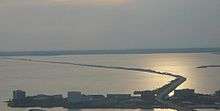
Transportation
Roads

Three motor vehicle bridges cross Tampa Bay to Pinellas County from Tampa city limits: the Howard Frankland Bridge (I-275), the Courtney Campbell Causeway (SR 60), and the Gandy Bridge (U.S. 92). The old Gandy Bridge was completely replaced by new spans during the 1990s, but a span of the old bridge was saved and converted into a pedestrian and biking bridge renamed The Friendship Trail. It is the longest overwater recreation trail in the world.[148] However, the bridge was closed in 2008 due to structural problems.[149]

There are two major expressways (toll) bringing traffic in and out of Tampa. The Lee Roy Selmon Expressway (SR 618) (formerly known as the Crosstown Expressway), runs from suburban Brandon at its eastern terminus, through Downtown Tampa, to the neighborhoods in South Tampa (near MacDill Air Force Base) at its western terminus. The Veterans Expressway (SR 589), meanwhile connects Tampa International Airport and the bay bridges to the northwestern suburbs of Carrollwood, Northdale, Westchase, Citrus Park, Cheval, and Lutz, before continuing north as the Suncoast Parkway into Pasco and Hernando counties.
Three interstate highways run through the city. Interstate 4 and Interstate 275 cut across the city and intersect near downtown. Interstate 75 runs along the east side of town for much of its route through Hillsborough County until veering to the west to bisect New Tampa.
Along with highways, major surface roads serve as main arteries of the city. These roads are Hillsborough Avenue (U.S. 92 and U.S. 41), Dale Mabry Highway (U.S. 92), Nebraska Avenue (U.S. 41/SR 45), Florida Avenue (U.S. 41 Business), Bruce B. Downs Boulevard, Fowler Avenue, Busch Boulevard, Kennedy Boulevard (SR 60), Adamo Drive, and Dr. Martin Luther King Jr. Boulevard.
Airports
Tampa is served by three airports (one in Tampa, two in the metro area) that provide significant scheduled passenger air service:
- Tampa International Airport (IATA: TPA) is Tampa's main airport and the primary location for commercial passenger airline service into the Tampa Bay area. It is also a consistent favorite in surveys of the industry and the traveling public. The readers of Condé Nast Traveler have frequently placed Tampa International in their list of Best Airports, ranking it #1 in 2003,[150] and #2 in 2008[151] A survey by Zagat in 2007 ranked Tampa International first among U.S. airports in overall quality.[152] During 2008, it was the 26th-busiest airport in North America.[153]
- St. Petersburg-Clearwater International Airport (IATA: PIE) lies just across the bay from Tampa International Airport in neighboring Pinellas County. The airport has become a popular destination for discount carriers, with over 90% of its flights are on low-cost carrier Allegiant Air.[154] A joint civil-military aviation facility, it is also home to Coast Guard Air Station Clearwater, the largest air station in the U.S. Coast Guard.[155]
- Sarasota–Bradenton International Airport (IATA: SRQ) is located in nearby Sarasota. Sarasota airport has more flights to Delta's Atlanta hub than any other city, but also serves several other large U.S. cities.[156]

Rail
Tampa's intercity passenger rail service is based at Tampa Union Station, a historic facility, adjacent to downtown between the Channel District and Ybor City. The station is served by Amtrak's Silver Star, which calls on Tampa twice daily: southbound to Miami and northbound for New York City.[157] Union Station also serves as the transfer hub for Amtrak Thruway Motorcoach service, offering bus connections to several cities in Southwest Florida and to Orlando.[157]
Uceta Rail Yard on Tampa's east side services CSX as a storage and intermodal freight transport facility. Freight and container cargo operations at the city's seaports also depend upon dockside rail facilities.[158]
Seaports

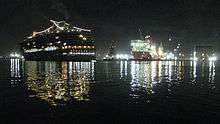
The Port of Tampa is the largest port in Florida in throughput tonnage, making it one of the busiest commercial ports in North America.[159] Petroleum and phosphate are the lead commodities, accounting for two-thirds of the 37 million tons of total bulk and general cargo handled by the port in 2009.[160] The port is also home to Foreign Trade Zone #79, which assists companies in Tampa Bay and along the I-4 Corridor in importing, exporting, manufacturing, and distribution activities as part of the United States foreign trade zone program.[161]
Weekly containerized cargo service is available in the Port of Tampa. Cargo service is offered by Ports America, Zim American Integrated Shipping Company, and MSC which has recently partnered with Zim. Currently 3,000 to 4,250 TEU containerships regularly call the Port of Tampa.
The bay bottom is very sandy, with the U.S. Army Corps of Engineers constantly dredging the ship channels to keep them navigable to large cargo ships.[162]
Mass transit
Public mass transit in Tampa is operated by the Hillsborough Area Regional Transit Authority (HART), and includes public bus as well as a streetcar line. The HART bus system's main hub is the Marion Transit Center in Downtown Tampa, serving nearly 30 local and express routes. HART is also currently making a bus rapid transit system called MetroRapid that will run between Downtown and the University of South Florida.
The TECO Line Streetcar System runs electric streetcar service along eleven stations on a 2.7-mile (4.3 km) route, connecting Ybor City, the Channel District, the Tampa Convention Center, and downtown Tampa.[163] The TECO Line fleet features varnished wood interiors reminiscent of late 19th and mid-20th century streetcars.[164]
Limited transportation by privately operated "Neighborhood Electric Vehicles" (NEV) is available, primarily in Downtown Tampa and Ybor City.[165] Water taxis are available on a charter basis for tours along the downtown waterfront and the Hillsborough River.
The Tampa Bay Area Regional Transportation Authority (TBARTA) develops bus, light rail, and other transportation options for the seven-county Tampa Bay area.
Healthcare

Tampa and its surrounding suburbs are host to over 20 hospitals, four trauma centers, and multiple Cancer treatment centers. Three of the area's hospitals were ranked among "America's best hospitals" by US News and World Report. Tampa is also home to many health research institutions. The major hospitals in Tampa include Tampa General Hospital, St. Joseph's Children's & Women's Hospital, James A. Haley Veterans Hospital, H. Lee Moffitt Cancer Center & Research Institute, and The Pepin Heart Institute. Shriners Hospitals for Children is based in Tampa. USF's Byrd Alzheimer's Institute is both a prominent research facility and Alzheimer's patient care center in Tampa. Along with human health care, there are hundreds of animal medical centers including a Humane Society of America.
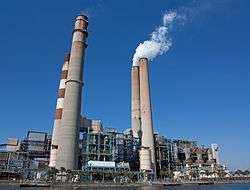
Utilities
Water in the area is managed by the Southwest Florida Water Management District. The water is mainly supplied by the Hillsborough River, which in turn arises from the Green Swamp, but several other rivers and desalination plants in the area contribute to the supply. Power is mainly generated by TECO Energy.
Notable people
Sister cities
Tampa has formalized sister city agreements with the following cities:[166]
|
See also
- Baldomero Lopez
- Largest metropolitan areas in the Americas
- List of public art in Tampa, Florida
- United States cities by population
- Seal of Tampa
Notes
- ↑ Mean monthly maxima and minima (i.e. the highest and lowest temperature readings during an entire month or year) calculated based on data at said location from 1981 to 2010.
- ↑ Official records for Tampa were kept at downtown from April 1890 to December 1940, Peter O. Knight Airport from January 1941 to 5 June 1946, and at Tampa Int'l since 7 June 1946. For more information, see ThreadEx
References
- ↑ "Ybor City: Cigar Capital of the World". Nps.gov. June 28, 1999. Retrieved July 5, 2013.
- ↑ "Alive: Ybor stumbled upon Guavaween". Sptimes.com. October 29, 1999. Retrieved July 5, 2013.
- ↑ "Table 3. Annual Estimates of the Resident Population for Incorporated Places in Florida: April 1, 2010 to July 1, 2011" (CSV). U.S. Census Bureau. Retrieved March 13, 2013.
- ↑ U.S. Census Bureau Annual Estimates of the Population of Metropolitan and Micropolitan Statistical Areas: April 1, 2010 to July 1, 2011, (EXCEL) Retrieved August 2, 2012
- 1 2 3 Kruse, Michael. "What are you called if you live in Tampa?". Tampa Bay Times. Retrieved April 26, 2014.
- ↑ "Tampa, Florida (FL) Zip Code Map – Locations, Demographics – list of zip codes". City-data.com. Retrieved 2010-02-23.
- ↑ "American FactFinder". United States Census Bureau. Archived from the original on September 11, 2013. Retrieved 2008-01-31.
- ↑ "US Board on Geographic Names". United States Geological Survey. October 25, 2007. Retrieved 2008-01-31.
- ↑ "John Thomas Lesley – 12th Mayor of Tampa". TampaGov. Retrieved March 22, 2010. Archived July 20, 2010, at the Wayback Machine.
- ↑ "Tampa". The American Heritage Dictionary of the English Language. Houghton Mifflin Harcourt. Retrieved December 4, 2011.
- ↑ "Find a County". National Association of Counties. Archived from the original on May 31, 2011. Retrieved 2011-06-07.
- 1 2 "Tampa, Florida: Census". Quickfacts.census.gov. Retrieved 2011-04-17.
- ↑ "Table 1. The 15 Fastest-Growing Large Cities from April 1, 2010, to July 1, 2011".United States Census Bureau. Retrieved 2011-03-18.
- ↑ "table with row headers in column A and column headers in rows 3 through 4 (leading dots indicate sub-parts)" (CSV). census.gov. Retrieved 2015-09-04.
- ↑ "Tampa Bay metro market hits milestone". Tampa Bay Business Journal- bizjournals.com. June 20, 2007. Retrieved 2008-02-23.
- ↑ "Tampa Bay, Florida Demographics". tampabay.us. Retrieved 2013-01-01.
- ↑ Ruiz, Rebecca. "In Depth: America's Best Cities For The Outdoors". Forbes.
- ↑ Reports (January 29, 2009). "For Nearly Half of America, Grass Is Greener Somewhere Else; Denver Tops List of Favorite Cities | Pew Social & Demographic Trends". Pewsocialtrends.org. Retrieved 2013-12-09.
- ↑ Danik, Sarah (May 10, 2004). "Top six cities for 20-somethings". Washington Square News.
- ↑ "GaWC – The World According to GaWC 2012". Lboro.ac.uk. January 13, 2014. Retrieved 2014-01-25.
- 1 2 Mulder, Kenneth. Tampa Bay: Days of Long Ago. P&M Pub. Co., 1990.
- ↑ Stewart, p. 231.
- ↑ Milanich, Jerald T. 1995. Florida Indians and the Invasion from Europe. University Press of Florida. ISBN 0-8130-1360-7 p. 40.
- ↑ "University of Georgia Libraries, Hargrett Rare Books and Manuscript Library: 1695 Spanish Map". Retrieved April 27, 2009.
- ↑ Dworkin y Méndez, Kenya C. (2002). "Cuban Theater, American Stage: Before Exile". In Luis, Ramos-García. The State of Latino Theater in the United States. Psychology Press. pp. 103–104. ISBN 0815338805. Retrieved July 16, 2014.
- ↑ Hewitt, Nancy A. (1991). "'The Voice of Virile Labor': Labor Militancy, Community Solidarity, and Gender Identity Among Tampa's Latin Workers, 1880–1921". In Baron, Ava. Work Engendered: Toward a New History of American Labor. Cornell University Press. pp. 142–167. ISBN 0801495431. Retrieved July 16, 2014.
- ↑ Milanich, Jerald T. 1995. Florida Indians and the Invasion from Europe. University Press of Florida. ISBN 0-8130-1360-7.
- ↑ "FAQ on the Black Seminoles, John Horse, and Rebellion". www.johnhorse.com. Retrieved 2009-12-25.
- 1 2 "ABOUT TAMPA BAY – PINELLAS COUNTY HISTORY – WEBCOAST PAGE TAMPA BAY TAMPA FLORIDA". www.webcoast.com. Retrieved 2008-02-24.
- ↑ "Excavators seeking freedom pioneers". St. Pete Times. Retrieved 2011-04-17.
- ↑ museumofcigars.com. "fort brooke". Museumofcigars.com. Retrieved 2010-02-23.
- ↑ Brown, Cantor. Tampa Before the Civil War. University Press of Florida.
- ↑ "Tampa travel guide – Tampa tourism and travel information". City-travel-guide.co.uk. Retrieved 2010-02-23.
- ↑ "1850 Census of Population" (PDF). Retrieved 2011-04-17.
- ↑ "Joseph B. Lancaster – 1st Mayor of Tampa". Tampagov.net. Archived from the original on June 15, 2008. Retrieved 2010-02-23.
- ↑ "Military Rule of Tampa During Civil War". www.tampagov.net. Retrieved 2008-02-23.
- ↑ "James McKay, Sr. – 6th Mayor of Tampa". www.tampagov.net. Archived from the original on June 15, 2008. Retrieved 2008-02-24.
- ↑ "Florida Civil War Battle Tampa Bay American War Between the States". americancivilwar.com. Retrieved 2008-02-24.
- ↑ "Battle Summary: Tampa, FL". www.nps.gov. Archived from the original on February 18, 2008. Retrieved 2008-02-24.
- ↑ "Hull of Civil War sloop likely found in Tampa river – St. Petersburg Times". Tampabay.com. Retrieved 2010-02-23.
- ↑ Brown, Cantor. Tampa During the Civil War and Reconstruction. University Press of Florida.
- ↑ "Archives, City of Tampa Incorporation History". www.tampagov.net. Retrieved 2008-02-23.
- 1 2 Lastra, Frank. Ybor City: The Making of a Landmark Town. 2006. University of Tampa Press.
- ↑ "About Bone Valley". Baysoundings.com. Retrieved 2011-04-17.
- ↑ Mormino, Gary. The Immigrant World of Ybor City. University Press of Florida
- ↑ Ybor City: The Making of a Landmark Town by Frank Lastra.
- ↑ "Gasparilla Pirate Festival – Tampa, Florida". Gasparillapiratefest.com. Retrieved 2010-02-23.
- 1 2 Kerstein, Robert. Politics and Growth in 20th Century Tampa. University Press of Florida. ISBN 0-8130-2083-2.
- ↑ Deitche, Scott. "The Mob". Weeklyplanet.com. Retrieved 2011-04-17.
- ↑ "Feature Articles 101". AmericanMafia.com. Retrieved 2011-04-17.
- 1 2 [Vintage Tampa Signs and Scenes]http:www.arcadiapublishing.com.
- ↑ "USF History". usf.edu. University of South Florida. Retrieved August 16, 2015.
- ↑ "Race and Hispanic Origin for Selected Cities and Other Places: Earliest Census to 1990". U.S. Census Bureau.
- ↑ http://etd.lib.fsu.edu/theses/available/etd-04152005-170723/unrestricted/05_lsj_CHAPTER_4_b.pdf
- ↑ Palm River Restoration. Archived June 9, 2007, at the Wayback Machine.
- 1 2 3 4 "Average Weather for Tampa, FL – Temperature and Precipitation". www.weather.com. Retrieved 2008-02-23.
- ↑ "Lightning capital of the nation". .sptimes.com. July 1, 1994. Retrieved 2011-04-17.
- ↑ CoCoRaHS database for June 25, 2012 (would be data for June 24, 2012 since readings for 24 hours end at 07:00 the next day) View CoCoRaHS Report
- ↑ McClure, Brian (May 21, 2010). "The Tampa Bay area has been lucky". Tampa Bay Times. Retrieved October 24, 2016.
- ↑ "Mean Number of Days With Minimum Temperature 32 °F (0 °C) or Less". National Climatic Data Center. June 23, 2004. Retrieved 2007-03-06.
- ↑ Cole, Brian (February 1, 2012). "Tampa Bay Area National Weather Service Climate Page". Tampa Bay Area National Weather Service. Tampa Bay Area National Weather Service. Retrieved October 15, 2015.
- ↑ Citrus farmers reeling from cold St. Petersburg Times, December 27, 1989.
- ↑ Squeezing Citrus St. Petersburg Times, August 22, 2003.
- ↑ According to CoCoRaHS observers and the National Weather Service.
- ↑ "NowData - NOAA Online Weather Data". National Oceanic and Atmospheric Administration. Retrieved 2016-04-11.
- ↑ "Station Name: FL TAMPA INTL AP". National Oceanic and Atmospheric Administration. Retrieved 2014-06-11.
- ↑ "WMO Climate Normals for TAMPA/INT'L ARPT FL 1961–1990". National Oceanic and Atmospheric Administration. Retrieved 2014-03-10.
- ↑ "Average Weather for Tampa, FL - Temperature and Precipitation". The Weather Channel. Retrieved 2011-10-03.
- ↑ "Floridian: Urban culture clash". Sptimes.com. Retrieved 2011-04-17.
- ↑ Thalji, James. "Times Staff Writer". Retrieved 2014-07-21.
- ↑ Weekly Planet Staff (June 7, 2006). "Downtowns on the Verge". Creative Loafing. Retrieved 2010-09-03.
- ↑ "High-rise Buildings of Tampa". Emporis.com. Retrieved 2008-06-17.
- 1 2 "Regions Building". Emporis.com. Retrieved 2008-06-16.
- ↑ "Film Florida". Film Florida. Retrieved 2011-04-17.
- ↑ Bayshore Boulevard Linear Park Archived December 18, 2009, at the Wayback Machine.
- ↑ Babe Zaharias Golf Course Archived April 22, 2009, at the Wayback Machine.
- ↑ The Story of Tampa Archived June 28, 2007, at the Wayback Machine.
- ↑ Emporis GmbH. "Park Tower". Emporis.com. Retrieved 2011-04-17.
- ↑ "Annual Estimates of the Resident Population for Incorporated Places: April 1, 2010 to July 1, 2015". Retrieved July 2, 2016.
- ↑ "CENSUS OF POPULATION AND HOUSING (1790–2000)". U.S. Census Bureau. Retrieved 2011-04-11.
- ↑ "Tampa (city) QuickFacts from the US Census Bureau". Quickfacts.census.gov. Retrieved July 5, 2013.
- ↑ 1850 census population included Fort Brooke, which was located outside the municipal limits.
- ↑ Not returned separately by enumerators in 1860.
- ↑ "Modern Language Association Data Center Results of Tampa, Florida". Mla.org. March 15, 2006. Retrieved 2011-04-17.
- ↑ "Tampa – Florida's Industrial Port City". Archived October 21, 2010, at the Wayback Machine. Florida History Internet Center. Retrieved February 27, 2010.
- 1 2 "Downtown Tampa: Its Cultural and Historical Significance". The Tampa Connection Project, TampaGov. Retrieved February 27, 2010.
- ↑ "Sacred Heart Parish History". Sacred Heart Catholic Church. Retrieved February 27, 2010.
- ↑ "Our History". St. James House of Prayer. Retrieved February 27, 2010. Archived July 16, 2011, at the Wayback Machine.
- ↑ Clinton, William Jefferson. November 3, 1996, "Remarks to the Congregation of St. Paul's AME Church". The Miller Center of Public Affairs at the University of Virginia. Retrieved February 27, 2010.
- ↑ "Landmark Structures". TampaGov. Retrieved April 26, 2010.
- ↑ "Messianic Covenant Congregations and Stewards". Messianiccovenant.com. Retrieved April 14, 2014.
- ↑ "Churches". Korean American Ministry Resources. Retrieved April 14, 2014.
- ↑ "New Light Church, Tampa, Florida". Korean First Baptist Church of Tampa. Retrieved April 14, 2014.
- ↑ "Tampa, FL Churches". Faith Street. Retrieved April 14, 2014.
- ↑ "Spiritual Life". University of Tampa. Retrieved 11 August 2016.
- ↑ "FEZANA Member Associations". Federation of Zoroastrian Associations of North America. Retrieved 11 August 2016.
- ↑ Pichaya Fitts (April 14, 2003). "'A little piece of Thailand'". Tampa Bay Times. Retrieved 2012-01-01.
- ↑ http://www.tampagurdwara.com/
- ↑ Church of Scientology Tampa. Retrieved February 27, 2010.
- ↑ Romano, John (May 21, 2012). "Tampa Bay ranks low in religion census". Tampa Bay Times. Retrieved April 15, 2014.
- 1 2 "Economic Development in the Tampa Bay Area". Tampachamber.com. Retrieved 2011-04-17.
- ↑ "FORTUNE 500 2007: FORTUNE annual ranking of America's largest corporations". Money.cnn.com. Retrieved 2011-04-17.
- ↑ Major Employers, Tampa Bay Partnership.
- ↑ "Tampa Downtown Partnership – Elevating The Potential". Tampasdowntown.com. Retrieved 2011-04-17.
- ↑ http://www.tampagov.net/dept_mayor/files/speech_march_2005.pdf
- ↑ Hinman, Michael (March 8, 2010). "Seven rental communities seek bankruptcy protection as multifamily struggles | Tampa Bay Business Journal". Bizjournals.com. Retrieved 2011-04-17.
- ↑ Snider, Eric. "More good news for CRE: Tampa Bay rental markets ranks high." Tampa Bay Business Journal. February 20, 2014.
- ↑ "NOAA Brownfield: Pilot Port, Tampa Bay, FL". noaa.gov. Retrieved 2006-05-13.
- ↑ Julie Sloane (October 10, 2007). "Wikimedia Foundation Moving To San Francisco". Wired. Retrieved 2011-10-23.
- ↑ "Business: Tampa Bay's new address: Upscale, USA". Sptimes.com. July 9, 2006. Retrieved 2011-04-17.
- ↑ America's Top 10 Party Cities Archived October 3, 2008, at the Wayback Machine.
- ↑ "Famed Tampa wrestler Jack Brisco dies at 68 – St. Petersburg Times". Tampabay.com. Retrieved 2011-04-17.
- ↑ "Former Wrestling Champ Found Dead in Tampa". .tbo.com. March 14, 2009. Retrieved 2011-04-17.
- ↑ "Tampabay: Now that's rasslin'". Sptimes.com. Retrieved 2011-04-17.
- ↑ "Hulk Hogan, Bubba the Love Sponge, help raise $70,000 for Plant City charity". Plantcity2.tbo.com. March 18, 2010. Retrieved 2011-04-17.
- ↑ "The Way The Music Died : The Earliest Days of Tampa Death Metal". Tampabay.com. Retrieved 2011-04-17.
- ↑ Andrew Huse. "Welcome to Cuban Sandwich City". Cigar City Magazine, Volume 1, Issue 2.
- ↑ Tampa names Ybor City-style Cuban as the city's signature sandwich – Tampa Bay Times
- ↑ Thomas C. Tobin (January 18, 2003). "To each, his own sandwich". St. Petersburg Times
- ↑ Otto, Steve (October 24, 2007). "Cuban Is Ours, Any Way You Try To Slice It". The Tampa Tribune. Archived from the original on May 7, 2009.
- 1 2 "Credentials". Big Cat Rescue. Retrieved September 19, 2015.
- ↑ "All Big Cat Tours". Big Cat Rescue. August 15, 2015. Retrieved September 19, 2015.
- ↑ Miller, Jen A. (March 31, 2010). "Vintage Clothing Shops Thriving in Tampa". The New York Times.
- ↑ "Neighborhood notes: Group helps promote Palma Ceia merchants – St. Petersburg Times". Tampabay.com. Retrieved 2010-02-23.
- ↑ "Cruise Sailing Schedule 2009/2010". Tampa Port Authority. Retrieved January 28, 2010.
- ↑ Sloan, Gene. February 23, 2010, "Norwegian Cruise Line to base ship in Tampa for first time", USA Today. Retrieved February 23, 2010.
- ↑ "TBO EXTRA Gasparilla". TBOEXTRA.com. Retrieved March 29, 2010.
- ↑ "Feature Events". TampaGov. Retrieved March 29, 2010.
- ↑ "Metrocon About Metrocon". Retrieved August 13, 2012.
- ↑ "GaYbor Days will make your Fourth fabulous – St. Petersburg Times". Tampabay.com. Retrieved 2010-02-23.
- ↑ "Clip ranks in top 25 events", August 1, 2008. Tampa International Gay and Lesbian Film Festival. Retrieved March 29, 2010.
- ↑ Feist, Brian. November 2007 "The Last Word", page 46. The Gazette. Retrieved March 29, 2010.
- ↑ http://www.usnews.com/news/entertainment/articles/2014/04/26/travolta-spacey-in-tampa-for-bollywood-oscars
- ↑ Brian Montopoli (May 12, 2010). "Tampa, Florida to Host 2012 Republican National Convention". CBS News. Retrieved 2011-10-23.
- ↑ "ArenaBowl - ARENAFOOTBALL.COM". www.arenafootball.com. Retrieved 2015-12-22.
- ↑ "Tampa Bay Bandits - USFL (United States Football League)". www.oursportscentral.com. Retrieved 2015-12-25.
- ↑ "USFL.info - Tampa Bay Bandits". www.usfl.info. Retrieved 2015-12-25.
- ↑ "Tampa Bay Rays can leave Tropicana Field contract". www.si.com. Retrieved 2016-01-19.
- ↑ "Group seeks land for Rays stadium in downtown Tampa". .tbo.com. May 19, 2010. Retrieved 2011-04-17.
- ↑ "About Us". Tampagov.net. March 31, 2011. Retrieved 2011-04-17.
- ↑ Anderson, Anne W. (2009). Insiders' Guide to the Greater Tampa Bay Area. Globe Pequot. pp. 264–265. ISBN 0-7627-5347-1. Retrieved May 12, 2011.
- ↑ Top 500 Ranked Universities for Highest Total Enrollment stateuniversity.com
- ↑ Anderson, Anne W. (2009). Insiders' Guide to the Greater Tampa Bay Area. Globe Pequot. p. 265. ISBN 0-7627-5347-1. Retrieved May 12, 2011.
- ↑ University of Tampa profile, UT website
- ↑ Anderson, Anne W. (2009). Insiders' Guide to the Greater Tampa Bay Area. Globe Pequot. p. 263. ISBN 0-7627-5347-1. Retrieved May 12, 2011.
- ↑ http://www.stetson.edu/law/about/home/tampa-law-center.php|accessdate= April 27, 2016
- ↑ Anderson, Anne W. (2009). Insiders' Guide to the Greater Tampa Bay Area. Globe Pequot. pp. 263–264. ISBN 0-7627-5347-1. Retrieved May 12, 2011.
- ↑ Friendship Trail Bridge Claims Status as Longest Overwater Recreation Trail Archived June 13, 2008, at the Wayback Machine.
- ↑ "It's Final: Friendship TrailBridge Is Closed". .tbo.com. December 23, 2008. Retrieved 2010-02-23.
- ↑ "Condé Nast Readers Rate Tampa International Best in the U.S.", March 6, 2003. Tampa International Airport.. Retrieved January 28, 2010.
- ↑ "NEWS RELEASE: TPA Still Admired After All These Years", September 29, 2008. Tampa International Airport.. Retrieved January 28, 2010.
- ↑ "Zagat Survey Releases Global Airlines Survey Covering 84 Airlines and 46 Major Airports", November 20, 2007. Zagat Survey.. Retrieved January 28, 2010.
- ↑ "Fact Sheet", August 24, 2009. Tampa International Airport.. Retrieved January 28, 2010.
- ↑ "St. Petersburg, FL: St. Petersburg-Clearwater International (PIE)". Bureau of Transportation Statistics (BTS), Research and Innovative Technology Administration (RITA), U.S. Department of Transportation. July 2014. Retrieved July 21, 2014.
- ↑ "Based Aircraft & Operations". GCR.. Retrieved February 18, 2010.
- ↑ "Sarasota/Bradenton, FL: Sarasota/Bradenton International (SRQ)". Bureau of Transportation Statistics (BTS), Research and Innovative Technology Administration (RITA), U.S. Department of Transportation. May 2014.
- 1 2 Amtrak Atlantic Coast Service. Retrieved January 21, 2010.
- ↑ Tampa Port Authority: General Cargo Facilities, Ports America Berths. Retrieved January 21, 2010. Archived August 27, 2012, at the Wayback Machine.
- ↑ "Tampa Port Authority". Flaports.org. Retrieved 2013-12-09.
- ↑ "Total Port, Port of Tampa, Florida: FY09 vs FY08", November 16, 2009. Tampa Port Authority.. Retrieved January 28, 2010.
- ↑ "Foreign Trade Zone #79"
- ↑ RUNNING OUT OF ROOM? Dredged Material Poses Challenges Archived December 3, 2008, at the Wayback Machine.
- ↑ "Streetcar Station Stops", 2007. TECO Line Streetcar System.. Retrieved January 28, 2010.
- ↑ "What Goes Around Comes Around", 2007. TECO Line Streetcar System.. Retrieved January 28, 2010.
- ↑ Agency to discuss regulating golf cart-like vehicles Archived April 10, 2009, at the Wayback Machine.
- ↑ "Tampa Sister Cities from City of Tampa website". Tampagov.net. Retrieved 2011-04-17.
- ↑ "Sister cities of İzmir". Izmir Metropolitan Municipality. Retrieved 2012-10-22.
- ↑ Florence, Jeanne. "Le Havre – Les villes jumelées" [Le Havre – Twin towns] (in French). Retrieved 2013-08-07.
- ↑ "Le Havre – Les villes jumelées" [Le Havre – Twin towns] (in French). Archived from the original on July 29, 2013. Retrieved 2013-08-07.
Bibliography
- Brown, Canter (1999). Tampa before the Civil War. Tampa: University of Tampa Press. ISBN 978-1-879852-64-8.
- Brown, Canter (2000). Tampa in Civil War & Reconstruction. Tampa: University of Tampa Press. ISBN 978-1-879852-68-6.
- Cinchett, John (2009). Vintage Tampa Signs and Scenes. Tampa: Arcadia Publishing. ISBN 978-0-7385-6836-2.
- Kerstein, Robert (2001). Politics and Growth in Twentieth-Century Tampa. Gainesville, FL: University Press of Florida. ISBN 0-8130-2083-2.
- Lastra, Frank (2005). Ybor City: the Making of a Landmark Town. Tampa: University of Tampa Press. ISBN 978-1-59732-003-0.
- Milanich, Jerald (1995). Florida Indians and the Invasion from Europe. Gainesville, FL: University Press of Florida. ISBN 0-8130-1360-7.
- Mormino, Gary (1998). The Immigrant World of Ybor City. Gainesville, FL: University Press of Florida. ISBN 978-0-8130-1630-6.
- Pizzo, Anthony (1968). Tampa Town 1824–1886: Cracker Village with a Latin Accent. Tampa, Fl: Hurricane House.
- Pizzo, Anthony (1983). Tampa the Treasure City. Tulsa, OK: Continental Heritage Press. ISBN 978-0-932986-38-2.
- Stewart, George (2008). Names on the Land: a Historical Account of Place-Naming in the United States. New York: NYRB Classics. ISBN 978-1-59017-273-5.
External links
- Official website
- Tampa Bay Convention and Visitors Bureau
- Tampa Chamber of Commerce
- Tampa website dedicated to historic Tampa photographs
- Tampa Bay at DMOZ
- Tampa Changing – Historical and modern photographs of Tampa
- National Park Service Battle Description of the Battle of Fort Brooke and Ballast Point


